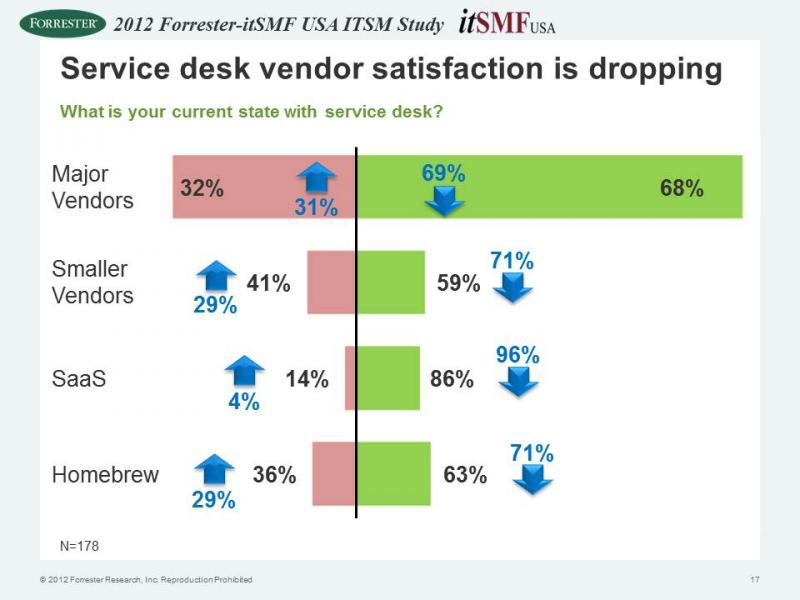More ITSM Tool Bells And Whistles, And Where The Real Focus Of Vendor Attention Should Be
October 2012 has been a busy month for IT service management (ITSM) tool vendor press releases, such as (in chronological order):
- BMC announced updates to its ITSM portfolio across BMC Remedy IT Service Management Suite 8.0, BMC FootPrints 11.5, BMC Remedyforce, and BMC Track-It! on October 9.
- Citrix announced GoToAssist Service Desk on October 17 (post Beetil acquisition).
- HP announced its new software-as-a-service (SaaS) offering – HP Service Anywhere – on October 22.
- ServiceNow released Q3 earnings and announced 145 new customers on October 24.
- CA Technologies announced CA Nimsoft Service Desk 7 at the itSMF USA’s Fusion 12 conference (and no doubt there will be other announcements at Fusion that I haven’t been pre-briefed on).
So lots of news on ITSM tool “enhancements” …
… BUT are ITSM tools “evolving” in the Darwinian sense?
There’s definitely a lot going on in the world of ITSM-enabling technology – and in this one sentence “I say it all” … are we not too focused on the technology rather than the organization that uses it? In particular, on adding new capabilities in a piecemeal manner based on the incontinence-inducing excitement around social, cloud, mobile, etc. (and ITIL), rather than trying to maximize the benefits or value customers gain from the offerings?
To reinforce my point: while recently facilitating a service assurance roundtable, the attendees very quickly focused on the pressures of, and issues with, mobility, BUT after the room had discussed security, device management, device selection, BYOD, etc. (i.e., the technology), it was up to me to ask, “What about the reason for having mobility, i.e., the customer and their need to access services on the move?” “It’s not like IT to forget the customer,” I hear you cry ironically. Sadly, we as IT-centric customers of software vendors drive much of this disconnect.
Survival of the fittest: an update on ITSM vendor satisfaction …
Today, at Fusion 12, my colleague Glenn O’Donnell presented the interim results (the survey is still open) of the annual itSMF USA and Forrester ITSM survey, and it’s not good news on ITSM tool vendor satisfaction – with dissatisfaction increasing across all vendor categories as per below. For example, dissatisfaction with SaaS tools has jumped from 4% to 14%, but it's still a lot lower than the other categories.

Interestingly, the smallest move has been with the major vendors that have managed to just about stay static – which IMO is testament to much of the work they have been doing outside of “technology enhancement,” i.e., … wait for it … work focused on better understanding customer needs and expectations, and the ability of their tools to consistently meet these needs and expectations over time. BMC, CA Technologies, and HP have in particular been focused on “the customer,” and I am hopeful that the 2013 survey will show an upward arrow for satisfaction as these vendors start to move in the right direction.
The large jump in “smaller vendor” dissatisfaction is an interesting one that goes against the recent interest in smaller, ITSM-focused tool vendors that are often perceived to be more customer-centric than the Big Four when it comes to ITSM. This needs further analysis of the survey responses.
Is this really customer centricity at work?
In previous blogs I’ve outlined many of the common issues with IT support groups and their distinct lack of customer centricity let alone customer service (some of which I admit has been caused by the constant pressure to cut costs). Are we starting to see a similar need from an ITSM tool and vendor perspective? I’d like to think that we are. Something’s got to give. Not only in respect of the common drivers of ITSM tool dissatisfaction, but also in terms of the ongoing vendor-customer relationship that goes beyond support and into achieving real success.
The work of my Customer Experience colleagues (documented in Forrester’s Outside In book and the blogs of its authors, the most recent being Why Some Companies Succeed – For Now – Despite Their Poor Customer Experience) shows what a difference customer experience can make to company success – so why not for ITSM tool vendors? After all, these vendors should be selling “solutions to business issues,” not just technology or ITIL-enabling capabilities.
So that’s my POV, what’s yours? As always your comments are appreciated.
My thanks to colleagues John Rakowski, Eveline Oehrlich, and Glenn O'Donnell, who contributed to this blog.